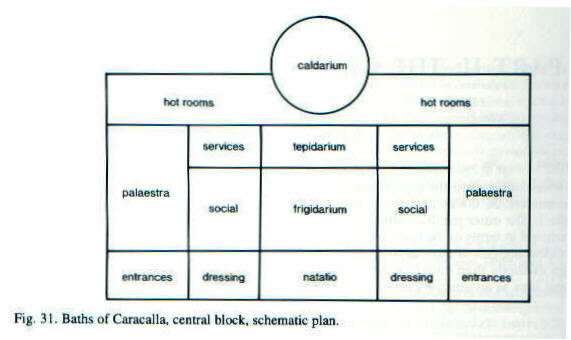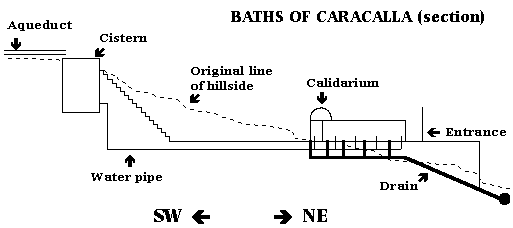
The Building Plan

The Baths of Caracalla consisted of a massive series of rooms that covered over 26 acres in the outskirts of the early 3rd Century AD Rome. The Baths took the shape of a traditional bath complex up until that point. It was rectangular and symmetrical, consisting of a central block flanked on both sides by a gymnastics area. The complex was set up in this main way:

Water Sources
The water supply and drainage system for the Roman baths required planning and skill to ensure that the water moved freely through the numerous rooms. (Calculations reveal that the Baths used between 15-20,000 cubic meters of water daily.) The Baths of Caracalla were fed by a branch of the Aqua Marcia aqueduct, which brought spring water into Rome from the hills near Subiaco, Italy (90 km away). The water flowed into a large cistern, which was divided into 18 sections to be manageable to maintain. The cistern could hold 10,000 cubic meters of water. From the cistern, the water flowed by gravity through a series of pipes underneath the garden to the main building.

Once inside the main building, the water traveled through a series of pipes directly into the cold pools or into boilers over wood fires for the warm and hot baths. Outlets in the floor of the rooms carried the water to the drains, which took the waste water to the municipal drain. Both the distribution and drainage pipes were houses in large tunnels that were accessible to maintenance and inspection. There were also tunnels underneath which stored the vast amounts of timber needed to keep the fires going all day for the water and steam rooms.
Heating the Baths
The heated rooms lay on the southwest side of the building and extend past the line of the buildings to increase the access to the sun's rays. However, the rooms were also heated by the hypocaust system, which worked because the floor was raised on small columns or stacks of tiles which allowed hot air from a wood fire to circulate underneath. The hot air was then piped into the walls to create a constant 100% humidity environment in the laconicum (hot, dry room) which also laid on the southwest side of the building and the caldarium. As if it wasn't hot and humid enough in Rome in the summer, it was even hotter in the Baths.